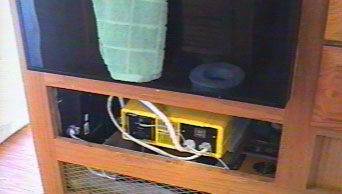 Inverter
Inverter 
 Inverter
Inverter 
|
Introduction 120v AC Power Inverter |
|
|
| The inverter converts power
from the 12 volt batteries to 120 volt AC power.
Some inverters produce a sine wave others create a square or modified square wave. Without the sine wave some hand-tool battery chargers may be damaged, laser printers may print light background lines, TVs may have some picture interference. A digital display of the power load is handy. With it you'll know how much power is being used (even when everything is off.) TVs, VCRs, satellite receivers, and PC monitors all consume power even when turned off. Adding a switched power strip eliminates these needless power drains. Our electronic equipment, turned off
but plugged in, uses 10 amps DC or 120 amp-hours per day. That's
about 60% of the battery's usable capacity.
|
 We
selected the Prosine 1800 made by Statpower.
I was attracted to this unit because of the small size and light weight.
Originally, I was looking at 2400 watt units with built-in chargers.
Now I realize 1800 watts is all we need. We
selected the Prosine 1800 made by Statpower.
I was attracted to this unit because of the small size and light weight.
Originally, I was looking at 2400 watt units with built-in chargers.
Now I realize 1800 watts is all we need.
If both Dish TVs, the microwave oven and the hair drier
are on, we may require more than 1800 watts. We don't need all of
this simultaneously.
A remote panel allows easy monitoring of the power status and is convenient for turning the inverter on or off. Also, don't forget to turn off the power strips connected to TV's etc. |
|
|
|
||
ã
copyright Nodland 1999-2020